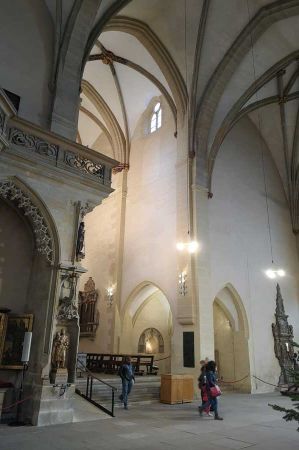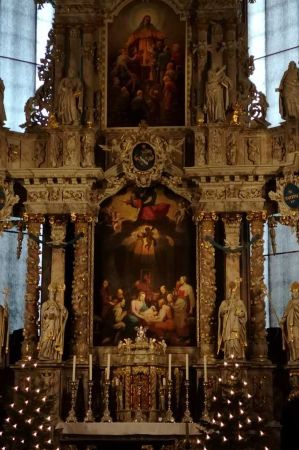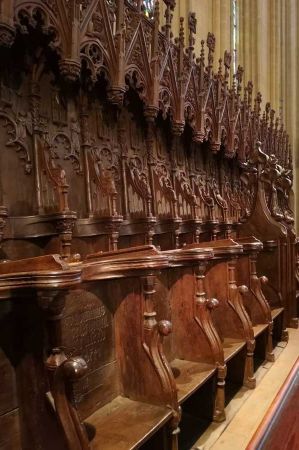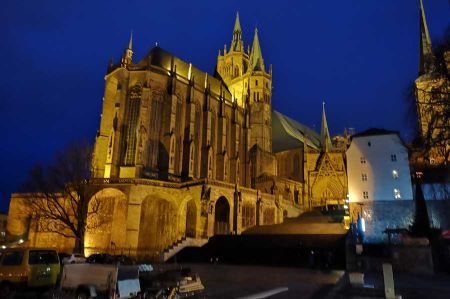Erfurt - the Ensemble of cathedral and Severi Church
- Written by Portal Editor
It is already a monumental impression that opens up before your eyes when you walk across the Krämerbrücke through the shopping street towards the cathedral and the huge market square then surprisingly opens up, in the background the imposing cathedral building and the Severi Church.
Both are considered landmarks of the city of Erfurt and form this probably unique ensemble on Domplatz. 70 steps lead up to the cathedral, which also owns the so-called Gloriosa, the largest free-swinging medieval bell in the world. The bell casted in 1497 is 2.57 meters high, measures 2.54 meters in diameter and weighs 11,450 kilograms. Unfortunately, the gloriosa is today only rung for special events and church holidays.
The Erfurt Cathedral is the oldest church building in Erfurt
 The Erfurt Cathedral, formerly also known as the Marienkirche or the Propsteikirche Beatae Mariae Virginis, is the most important and oldest church building in Erfurt. To the top of the bell building it is a proud 81.26 m of height. Despite the imposing building complex, the cathedral only served as a bishopric for a short time (around the middle of the 8th century) and was the seat of the collegiate foundation of St. Marien throughout the Middle Ages until the early 19th century. Since 1994 it has been the cathedral of the newly created diocese of Erfurt and the seat of the cathedral chapter.
The Erfurt Cathedral, formerly also known as the Marienkirche or the Propsteikirche Beatae Mariae Virginis, is the most important and oldest church building in Erfurt. To the top of the bell building it is a proud 81.26 m of height. Despite the imposing building complex, the cathedral only served as a bishopric for a short time (around the middle of the 8th century) and was the seat of the collegiate foundation of St. Marien throughout the Middle Ages until the early 19th century. Since 1994 it has been the cathedral of the newly created diocese of Erfurt and the seat of the cathedral chapter.
Right next to it - the Severikirche
The Severikirche is a church building of the Roman Catholic Church, which due to its unusual shape, it seems to anticipate the late Gothic hall church, is one of the most important Gothic buildings in Germany. The bones of church patron Severus von Ravenna rest in an artistically very important sarcophagus.
An older St. Pauls Church stood on the site of today's church, but no archaeological remains were found during archaeological excavations in 1960/61 immediately north of the church. It must therefore remain open when and by whom it was founded. In parts, its establishment is still attributed to Boniface. In 708, a Benedictine monastery, perhaps even with nuns, is said to have been named St. Paul. In 836 Archbishop Otgar von Mainz (826–847) had transferred the bones of St. Severus from Ravenna to Erfurt in the Benedictine convent of St. Paul, an altum monasterium.
Boniface - first mission trip to the Frisians
 Erfurt was already an important center of power in the Thuringian and Franconian empires. Pope Gregory II (715–731) had asked the Thuringians in 724 to build a “house” for Boniface, who was missionary here. Allegedly, this request has already been met in 725. In 741/42, Boniface asked Pope Zacharias to confirm the establishment of a bishopric "at the place called" Erphesfurt ", which had long been a settlement or castle (urbs) of pagan farmers".
Erfurt was already an important center of power in the Thuringian and Franconian empires. Pope Gregory II (715–731) had asked the Thuringians in 724 to build a “house” for Boniface, who was missionary here. Allegedly, this request has already been met in 725. In 741/42, Boniface asked Pope Zacharias to confirm the establishment of a bishopric "at the place called" Erphesfurt ", which had long been a settlement or castle (urbs) of pagan farmers".
In 716 Boniface undertook a first mission trip to the Frisians. However, this failed due to the Friesian Duke Radbod, an opponent of the Christian-Franconian missionary mission, who had just recaptured Southwest Friesland from the Franks. Boniface then moved through areas in what is now Hesse, Thuringia and Bavaria for over twelve years.
Boniface's missionary journeys can be thought of as real expeditions, on which he embarked on warriors, artisans and a large retinue to establish branches and monasteries. His missionary wish met with the interests of the Franconian Hausmeier Karl Martell, who saw a staple in Christianity and in a tightly organized imperial church that seemed suitable to promote the cohesion of his empire. After his second trip to Rome in 723, he issued Boniface a letter of protection with which he returned to his missionary area.
Boniface falls the Donara oak
 In his Vita sancti Bonifatii, the priest Willibald of Mainz reports on a special event near Geismar, where the Donara oak, dedicated to the God Donar, stood and was worshiped for a long time. The north Hessian town of Geismar, within sight of the Franconian fortress Büraburg, is now part of Fritzlar. According to Willibald, Boniface decided to cut down this oak. The numerous attendees, according to Willibald including a large number of Frisians, eagerly awaited the reaction of the Germanic deity Donar, to whom the oak was dedicated. They were deeply impressed that this did not happen.
In his Vita sancti Bonifatii, the priest Willibald of Mainz reports on a special event near Geismar, where the Donara oak, dedicated to the God Donar, stood and was worshiped for a long time. The north Hessian town of Geismar, within sight of the Franconian fortress Büraburg, is now part of Fritzlar. According to Willibald, Boniface decided to cut down this oak. The numerous attendees, according to Willibald including a large number of Frisians, eagerly awaited the reaction of the Germanic deity Donar, to whom the oak was dedicated. They were deeply impressed that this did not happen.
In his writings, Boniface describes, among other things, trees consecrated to the Donar as idols, the veneration of which, according to Christian teaching, violates the Ten Commandments. It can be assumed that he wanted to send a signal to those who had converted to Christianity in order to prevent them from revering.
With the felling of the oak, Bonifatius may also have intended to demonstrate, by means of a symbolic act, the superiority of the one God of Christians over the impoverished old gods and their local cults and to initiate a fundamental religious reorganization. He let the holy one out of the oak wood. Build an oratory dedicated to Peter.
Please read as well:
A short trip to Erfurt - Krämer Bridge is the target
Hike to the ruins of Kunitz Castle, Castle on Gleißberg
-
 Erfurt - medieval Dom and Severi Church
Erfurt - medieval Dom and Severi Church
Erfurt - medieval Dom and Severi Church
Erfurt - medieval Dom and Severi Church
-
 Erfurt - medieval Dom and Severi Church
Erfurt - medieval Dom and Severi Church
Erfurt - medieval Dom and Severi Church
Erfurt - medieval Dom and Severi Church
-
 Erfurt - medieval Dom and Severi Church
Erfurt - medieval Dom and Severi Church
Erfurt - medieval Dom and Severi Church
Erfurt - medieval Dom and Severi Church
-
 Erfurt - medieval Dom and Severi Church
Erfurt - medieval Dom and Severi Church
Erfurt - medieval Dom and Severi Church
Erfurt - medieval Dom and Severi Church
-
 Erfurt - medieval Dom and Severi Church
Erfurt - medieval Dom and Severi Church
Erfurt - medieval Dom and Severi Church
Erfurt - medieval Dom and Severi Church
-
 Erfurt - medieval Dom and Severi Church
Erfurt - medieval Dom and Severi Church
Erfurt - medieval Dom and Severi Church
Erfurt - medieval Dom and Severi Church
-
 Erfurt - medieval Dom and Severi Church
Erfurt - medieval Dom and Severi Church
Erfurt - medieval Dom and Severi Church
Erfurt - medieval Dom and Severi Church
-
 Erfurt - medieval Dom and Severi Church
Erfurt - medieval Dom and Severi Church
Erfurt - medieval Dom and Severi Church
Erfurt - medieval Dom and Severi Church
-
 Erfurt - medieval Dom and Severi Church
Erfurt - medieval Dom and Severi Church
Erfurt - medieval Dom and Severi Church
Erfurt - medieval Dom and Severi Church
-
 Erfurt - medieval Dom and Severi Church
Erfurt - medieval Dom and Severi Church
Erfurt - medieval Dom and Severi Church
Erfurt - medieval Dom and Severi Church
-
 Erfurt - medieval Dom and Severi Church
Erfurt - medieval Dom and Severi Church
Erfurt - medieval Dom and Severi Church
Erfurt - medieval Dom and Severi Church
-
 Erfurt - medieval Dom and Severi Church
Erfurt - medieval Dom and Severi Church
Erfurt - medieval Dom and Severi Church
Erfurt - medieval Dom and Severi Church
https://www.alaturka.info/en/blog-en/4934-caravan-jaarbeurs-there-is-a-lot-to-see-and-do#sigProIdd24b7ce108

